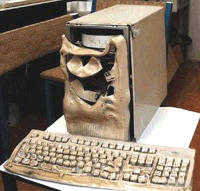Hardware Lifecycle Planning
 One of these days, the computer on your desk will die. In the last week, I've had a number of conversations with my clients, and with the attendees at the YMCA Technology Conference in Raleigh, about how they deal with this fact of life. Not surprisingly there are a good many small non-profits out there that do not budget for the replacement of the their computers. When a computer dies, the organization's ad hoc high priestess of tech goes to the executive director and begs for some money to buy a new pc. Once her prayers are answered she makes a few frantic phone calls to see how quickly a new computer can be dragged in. The bereaved staff member, meanwhile, either works from home or floats from office to office until the new box is in place. Not a pretty picture. But it avoids having money encumbered for a need that might not arise this year. It might seem like a reasonable trade-off in an environment where money is always a bit scarce. But the failure to budget for routine desktop replacement - not to mention the replacement of other components from file servers down to power strips - has a serious hidden cost. When devices are replaced with no schedule, and always on an urgent basis, the network equipment tends to become more and more varied. I'm sure you've seen it: five pcs on XP, five on Win 2000, and two ancient boxes on 98 that just won't die. Each one running a slightly different mix of standard software apps. This mishmash leads to hidden expense, as the support of these users becomes incrementally more difficult. Sarah's laptop can't come up on the old projector; Joe is back on Excel 97; the graphics software won't work with Jack's video card. It's hard to tally this expense, but it's there, making your work just a little more time consuming every day. And as you grow, the harm caused by this heterogenous network will mushroom. If you have multiple sites, so that you are often giving phone or online support, the problem is even worse. The organization successfully deferred an expense until the last moment - but how much staff time and productivity -- how much focus on mission -- was lost in minor computer problems everyone has just learned to live with? The solution for many organizations I talked to was to plan for the lifecycle of their desktops and other devices, and replace them at the end of this cycle even if they are still running. For example, they might decide a desktop computer has a three year life. So they set up a rolling replacement schedule, in which each year they replace a third of the computers. This way each wave of machines is purchased from the same vendor and be similarly configured. This schedule can include a spare computer or two kept on the premises, so that when the CFO's pc melts down during an audit, you don't have to run out during your lunch break and get him whatever you can find at Best Buy. Several non-profit execs - at the Ys and elsewhere - told me that they found leasing to be a valuable tool in moving to this type of scheduled replacement. When the lease is up, they return the boxes, get a new set, and start another cycle. And the lease payment schedule creates a regular budget item, month in and month out, eliminating the sudden and always unexpected expense of machine replacement. But others reported that leasing was difficult to manage. One of our clients, who at this point has over 150 desktop computers, said the return of leased items -- which required they match up by serial number each system unit, keyboard, mouse, and monitor as it was when it was delivered to them -- was next to impossible. So they buy all their computers outright, and replace them on a rolling schedule. You hear a lot of talk nowadays about technology planning. Hardware lifecycle planning is a good place to start. Technorati Tags: nptech, tech_planning, ymca |




Comments on "Hardware Lifecycle Planning"
-
 Anonymous said ... (October 25, 2005 at 6:53 AM) :
Anonymous said ... (October 25, 2005 at 6:53 AM) :
post a commentVery interesting and attention getting blog, could I tell a friend? I really enjoy this stuff, mind if I come often? Anyway, thanks for making such a great blog, I'll be back to make a contribution.
we have 2-10 blog on blogspot network. this blogs belong to information technology. If you interested link with our bogs put this link in your site keyword : Build ur pc
Build ur pc
online guide on computer hardware
ok bye....